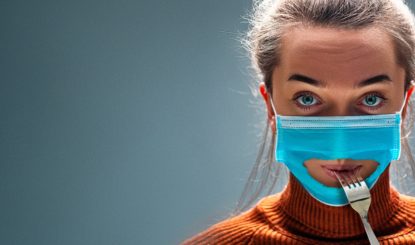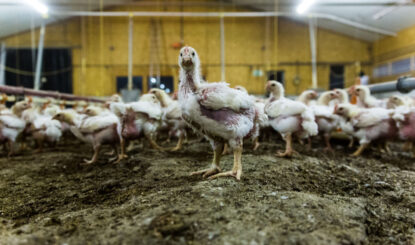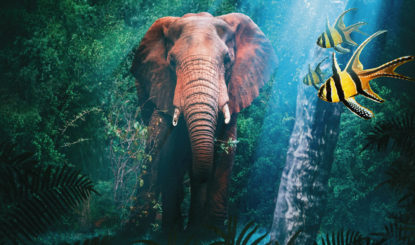4 reasons why zoonoses such as COVID-19 are on the rise
Approximately 60% of new infectious diseases are zoonoses–diseases spread from animals to humans. Most of them, over 70%, come from wild animals. Since the 1980s, every ten years, the number of new infectious diseases has more than tripled. More than two of these diseases are of animal origin. What are the factors behind this? And why are there more and more of these zoonoses?
Ebola, Nipah, SARS, the swine flu, MERS, HIV, BSE, the avian flu, and now COVID-19 (SARS-CoV-2): In April of this year, as part of its #BecauseWeEatAnimals campaign, Fondation Franz Weber introduced the epidemics and the pandemics that spread to humans via contact with (wild) animals. The World Health Organization (WHO) has been warning about zoonotic diseases since 2004, and has listed over 200 zoonoses. The destruction of natural habitats and the inappropriate containment of wild animals and livestock play a key role in the spread of these epidemics.
1. Ecosystem destruction
Humans are invading natural habitats more and more, especially via deforestation, the unfettered expansion of farmland, infrastructure development, and wildlife exploitation. Recent scientific research has shown that new infectious diseases are more widespread in tropical regions. These regions are historically wooded and rich in species. Their natural habitats have been have destroyed, spoiled, and urbanised by humans. Habitat loss dramatically changes fragile ecosystems, and species that previously were not in close contact with humans are closer to them. Changes in habitat force wild animals and the pathogens they carry to move elsewhere. This includes zones inhabited by humans.
This situation increases the probability that pathogens which would never leave the animal they colonise under normal circumstances are spread to humans.
2. Wildlife trade
Scientific studies have shown that various epidemics such as the coronavirus (SARS-CoV, MERS-CoV, and SRAS-CoV-2) can be traced back to the animal trade in so-called wet markets in China. Wet markets are markets that mainly sell (wild) animals that are still alive. The wild animals are considered as supposed miracle cures in Chinese medicine and/or as delicacies prized by a rich minority in China. These practices have historical roots: In the 1960s, the Chinese authorities authorised the private production of food. Some people specialised in hunting wild animals. As the years went on, a real wildlife industry was born, and its activities were often illegal.
All over the world, one can find stalls and markets selling animals that are vegetating, suffering, sick, dying, or already dead in cages that are too small. In these markets, the livestock are kept close to wild animals. This is dangerous, as all kinds of viruses of all kinds of origins are thus in contact with one another. This would never be the case in nature. These viruses are usually “calibrated” for their respective hosts and thus not a danger for other species. However, in wet markets, the animals are crammed into very enclosed spaces, in unhygienic conditions. The close co-existence of humans and animals under stress, weakened, and sometimes ill creates the ideal conditions for spreading a disease that may be lethal for humans. To prevent such epidemics in the future–and to save hundreds of animal species from extinction too–a total and definitive ban on the wildlife trade is essential.
3. Containment of animals
The origin of other epidemics such as the swine flu (H1N1) and mad cow disease (ESB) is the animal breeding industry. A global analysis of the spread of the avian flu (H5N1) revealed that poultry breeding is a risk factor in the spread of the pathogen. In general, the increased impacts of viruses are closely tied to global food production, and specifically to breeding. There is a direct connection between breeding and the destruction of natural habitats. An example of this is clearing tropical forests to produce animal feed. Switzerland also supports these practices. Since 1990, Switzerland had nearly tripled its animal feed imports.
The industrial breeding of large quantities of livestock also significantly increases the chances of the outbreak of a disease that could lead to an epidemic or a pandemic. The conditions under which industrially raised animals are contained, and the large number of contained animals, constitute a dangerous breeding ground for bacteria and viruses. Industrial breeding conditions decrease the resistance of animals. Weakened animals could cause the disease to spread. In industrial breeding, the eggs resemble each other, and the animals resemble each other too. For example, chickens from industrial farms tend to almost be genetic clones of one other, which encourages the spread of viruses.
All of these factors significantly increase the risk of diseases spreading between animals and humans. Scientists thus feared that the H1N1 swine flu virus, which is also very contagious for humans, and the H5N1 avian flu virus, which impacts mainly the animal kingdom, could have combined to form a superpathogen. This would have resulted in a very dangerous pandemic.
With its initiative against intensive farming, Fondation Franz Weber is calling for the abolition of this type of farming in Switzerland. In other words: no fattening sheds for 27,000 chickens, in which 17 chickens must be crammed into one square meter. No more pens in which 10 store pigs must live in a space equivalent to that of a car park, without space to lie down. The initiative also plans to ban the import of products of animal origin that do not comply with Swiss breeding conditions, as stipulated in the initiative.
4. Climate change / extinction of species
We are currently experiencing the largest mass extinction of animals and plants directly caused by human activity. Climate change, ecosystem destruction (see 1. Ecosystem destruction above) and the wildlife trade (see 2. Wildlife trade above) contribute to the extinction of wildlife species the world over, and thus to biodiversity loss. Each species plays a role in the Earth’s ecosystem. The extinction of a single species can threaten countless others. Climate change not only affects the habitat of various organisms, but can also impact their life cycle. These changes can also result in pathogens behaving in a new way, posing an increasing threat to our health. For example, ticks, which can spread various diseases, are spreading more and more. New species are migrating toward our part of the world. By slowing down climate change, we thus also protect ourselves against the spread of diseases.
To prevent new epidemics and pandemics in the future, it is extremely urgent to change our mindset. We must change how we behave with nature and animals! Our heavy interference in natural habitats, not only by us humans, but also by our livestock, heightens the risk of spreading zoonoses. The more often humans and animals are in contact with each other, the more pathogens can spread from one species to another. Scientists work on the assumption that in the future, diseases will spread more frequently and more rapidly, killing more people, thus impacting the economy even more. To reduce the risk of a new pandemic, protecting nature must be at the heart of the discussion on global (human) health: We, as humans, must realise the impact of our food habits on our future–and on our survival! The current crisis provides an opportunity to fundamentally rethink our farming and food habits. #BecauseWeEatAnimals


